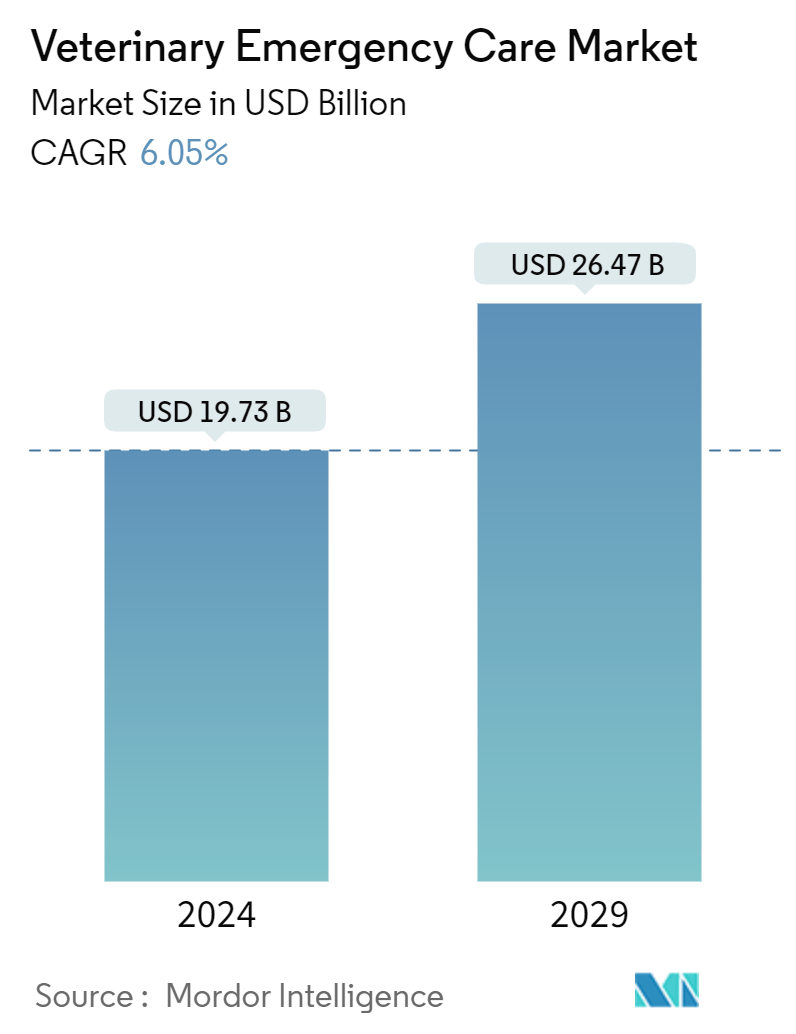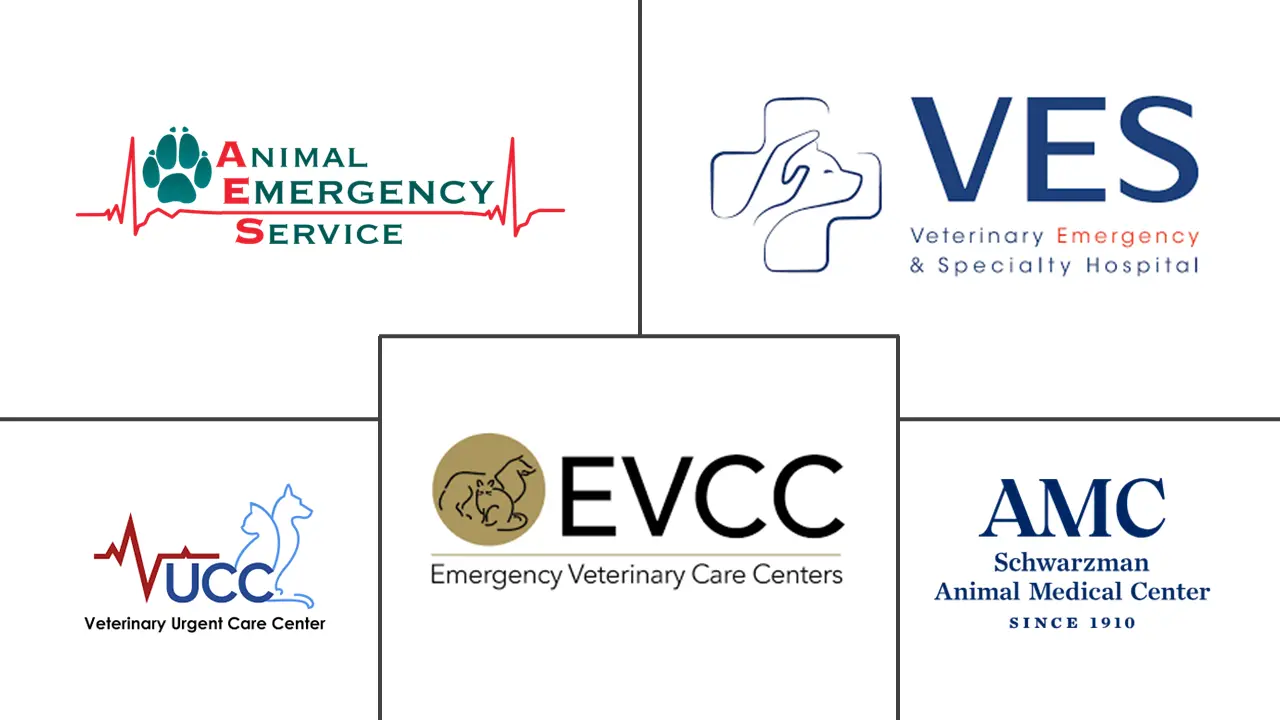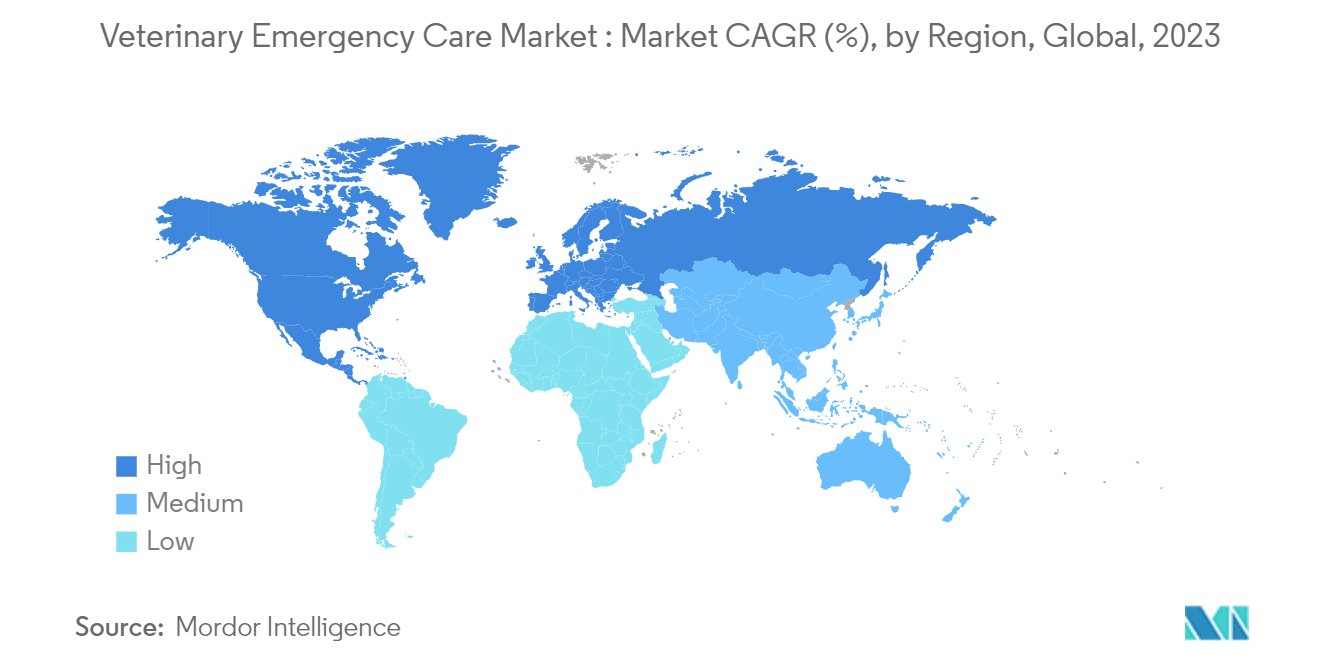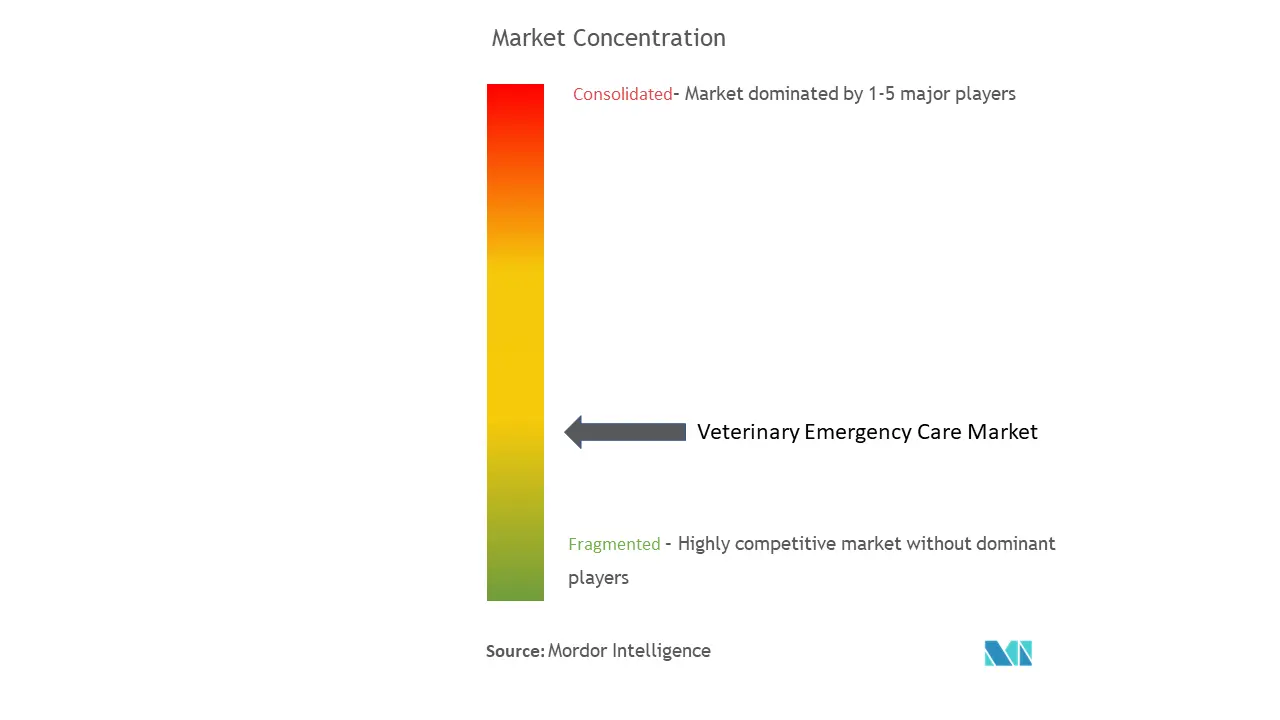Veterinary Emergency Care Market Size

| Study Period | 2019 - 2029 |
| Market Size (2024) | USD 19.73 Billion |
| Market Size (2029) | USD 26.47 Billion |
| CAGR (2024 - 2029) | 6.05 % |
| Fastest Growing Market | North America |
| Largest Market | Asia Pacific |
Major Players
*Disclaimer: Major Players sorted in no particular order |
Veterinary Emergency Care Market Analysis
The Veterinary Emergency Care Market size is estimated at USD 19.73 billion in 2024, and is expected to reach USD 26.47 billion by 2029, growing at a CAGR of 6.05% during the forecast period (2024-2029).
International collaboration is an emerging strategy in this market. Emerging market players are indulging in partnerships with educational organizations to enhance the skills of veterinarians and address the growing demand for veterinary emergency service care in developing economies. For instance, in December 2022, UW School of Veterinary Medicine, a US organization, announced the introduction of training programs for veterinarians at the Emergency Management and Research Institute (EMRI) in Hyderabad, India. Skilled veterinarians are valuable assets to emergency clinics as each case is time-sensitive. Hence, increasing the availability of skilled veterinarians will likely assist centers in expanding their service offerings and propel overall market growth.
The adoption of new technology enhances efficiency and increases accessibility for pet owners. For instance, in September 2023, a study published by Instinct stated that around 60% of smaller emergency and urgent care hospitals in the United States implemented workflow improvements, while 47% incorporated new imaging/diagnostic technology, and 37% of small veterinary centers in the country got wearable devices. The implementation occurred after a 54% surge in patient volumes, per the State of Emergency and Specialty Veterinary Care report. Although adopting the technologies is likely to reflect on the pricing for pet owners, this strategy is expected to assist veterinary emergency care centers in retaining veterinarians and efficiently managing workload. Improvement in the workflow enhances the speed of the service delivery of the centers and increases the overall veterinary emergency market valuation through better revenue flow.
Increasing collaboration between veterinary groups and the government to address the shortage of emergency care services in emerging countries is considered a vital growth determinant for the market. For instance, in August 2023, the state government of Karnataka, India, launched an emergency helpline number for veterinary service with 290 veterinary ambulances and a team of professionals with each ambulance for rural areas in the state. The government fully sponsors the services offered under this initiative; thus, this service enables the low to middle-income population to avail of the service and expands the market to the under-developed areas of the country.
However, the high cost of emergency veterinary services is estimated to restrain market growth. The high cost reflects high operating expenses, surging prices of medications, and skilled labor.
Veterinary Emergency Care Market Trends
The Segment for Dogs is Expected to Hold a Significant Market Share During the Forecast Period
The segment for dogs is expected to dominate the market owing to the increasing number of pet dogs globally and market players' expanding range of services during the forecast period.
According to data from the European Pet Food Industry: Facts and Figures 2023 report, Europe is home to around 340 million companion animals, with approximately 46% of households owning at least one pet in 2022. In Germany, for instance, there were approximately 10.6 million pet dogs in 2022. As of July 2023, in the United States, 65.1 million households had a dog as a pet. Dogs were considered the most popular pet in the region per the statistics published by Forbes in July 2023. People in the United States spent USD 136.8 billion on their pets in 2022, an increase of 10.63% from 2021. The increasing pet ownership is likely to raise the requirement for veterinary emergency care and strengthen market valuation during the forecast period.
Along with increasing pet ownership, numerous regional governments are taking initiatives to offer cost-effective emergency care services. For instance, four municipal veterinary hospitals in Brazil offer free public services to thousands of pets. As of May 2023, there were 1.9 million dogs in Sao Paulo. The affordability of veterinary care is still a challenge for various pet owners in the city. The governing body allocated USD 5.3 million to these four municipal hospitals for 2023. Therefore, initiatives from non-profit organizations and governing bodies to fill the supply-demand gap in the veterinary emergency care market are expected to support the growth of the market during the forecast period.
The increasing trend of dogs as pets globally and the rising accessibility to veterinary hospitals are factors expected to propel the growth of the segment for dogs.

North America is Expected to Hold a Significant Market Share Over the Forecast Period
North America is anticipated to witness significant growth during the forecast period. This can be attributed to factors such as the increasing adoption of animals as pets and the strong presence of major market players engaged in various service compositions to increase the accessibility of emergency care.
Numerous large veterinary centers are launching emergency services centers to meet the growing demand for the market. For instance, in October 2022, NVA Canada reported an opening of specialty and emergency veterinary care in Nova Scotia, Canada. The facility also includes ambulatory care and offers 24/7 emergency care service. Similarly, in April 2023, Cedar Animal Hospital in the United States announced expanding its veterinary care services by entering the emergency services segment. The hospital opened a new veterinary emergency care with around 65-70 professionals and is expected to grow to 100-120 in the near future. The increasing number of emergency care facilities is anticipated to reduce the waiting time for patients and assist the overall market in addressing a larger patient base in minimal time.
Additionally, the strategic initiatives by market players are expected to propel the market’s growth in the region during the forecast period. Regional players are developing various business models to combine emergency care services with the price level of general care. For instance, in May 2023, a new clinic with an integrated business model of general and emergency clinics opened in Texas, United States. The clinic offers an emergency service at an examination cost of USD 99. The fee is around 40% less than that of the emergency clinic, and it operates only during the non-working hours of the general clinic. The new service composition of the clinic is likely to address the market limitation of the high cost of emergency care services and enhance the patient base by offering affordable services.
Such initiatives, along with the rising pet insurance in the region and expanding the accessibility of veterinary emergency care across all economic class populations without incurring high operational costs, are expected to have a positive impact on the overall market during the forecast period.

Veterinary Emergency Care Industry Overview
The veterinary emergency care market is fragmented and consists of several major and regional players. Major market players are expanding their service portfolio by incorporating emergency care units into hospitals. Hence, the rising adoption of companion animals and increasing pet insurance coverage are key attractions of the market. Some of the market players include Veterinary Emergency Care, Animal Emergency Service, Emergency Veterinary Care Centers (EVCC), Veterinary Urgent Care Center, The Animal Medical Center, VES Hospital Pte Ltd, Lakefield Veterinary Group, Royal Veterinary College, Elizabeth Street Veterinary Clinic, and Westside Emergency.
Veterinary Emergency Care Market Leaders
-
Animal Emergency Service Company
-
Emergency Veterinary Care Centers (EVCC)
-
Veterinary Urgent Care Center
-
VES Hospital Pte Ltd
-
The Animal Medical Center
*Disclaimer: Major Players sorted in no particular order

Veterinary Emergency Care Market News
- September 2023: Erie Canal Animal Hospital launched an urgent care service to address the increasing demand for veterinary emergency care. The treatment under this facility is expected to cover selective illnesses that require 24-hour hospitalization, such as diarrhea, ear infection, vomiting, and lameness.
- August 2023: Veterinary Emergency & Specialty Hospital opened a new 24/7 animal emergency care service in West Springfield, United States. This initiative was intended to address the lack of urgent care in the area that forces pet owners to travel long distances for emergency care. This facility is expected to fulfill the local requirement of veterinary emergency care.
Veterinary Emergency Care Market Report - Table of Contents
1. INTRODUCTION
- 1.1 Study Assumptions and Market Definition
- 1.2 Scope of the Study
2. RESEARCH METHODOLOGY
3. EXECUTIVE SUMMARY
4. MARKET DYNAMICS
- 4.1 Market Overview
-
4.2 Market Drivers
- 4.2.1 Growing Pet Ownership
- 4.2.2 Development of Infrastructure to Facilitate Emergency Care
-
4.3 Market Restraints
- 4.3.1 High Out-of-Pocket Cost Associated with the Treatment
-
4.4 Porter's Five Forces Analysis
- 4.4.1 Bargaining Power of Suppliers
- 4.4.2 Bargaining Power of Buyers/Consumers
- 4.4.3 Threat of New Entrants
- 4.4.4 Threat of Substitute Products
- 4.4.5 Intensity of Competitive Rivalry
5. MARKET SEGMENTATION (Market Size by Value - USD)
-
5.1 By Animal
- 5.1.1 Companion Animals
- 5.1.1.1 Dogs
- 5.1.1.2 Cats
- 5.1.1.3 Other Companion Animals
- 5.1.2 Livestock Animals
- 5.1.2.1 Poultry
- 5.1.2.2 Cattle
- 5.1.2.3 Sheep
- 5.1.2.4 Other Livestock Animals
-
5.2 By Application
- 5.2.1 Accidental Ingestion
- 5.2.2 Respiratory Distress
- 5.2.3 Gastrointestinal Disease
- 5.2.4 Seizures
- 5.2.5 Accidents
- 5.2.6 Other Applications
-
5.3 Geography
- 5.3.1 North America
- 5.3.1.1 United States
- 5.3.1.2 Canada
- 5.3.1.3 Mexico
- 5.3.2 Europe
- 5.3.2.1 Germany
- 5.3.2.2 United Kingdom
- 5.3.2.3 France
- 5.3.2.4 Italy
- 5.3.2.5 Spain
- 5.3.2.6 Rest of Europe
- 5.3.3 Asia-Pacific
- 5.3.3.1 China
- 5.3.3.2 Japan
- 5.3.3.3 India
- 5.3.3.4 Australia
- 5.3.3.5 South Korea
- 5.3.3.6 Rest of Asia-Pacific
- 5.3.4 Middle East and Africa
- 5.3.4.1 GCC
- 5.3.4.2 South Africa
- 5.3.4.3 Rest of Middle East and Africa
- 5.3.5 South America
- 5.3.5.1 Brazil
- 5.3.5.2 Argentina
- 5.3.5.3 Rest of South America
6. COMPETITIVE LANDSCAPE
-
6.1 Company Profiles
- 6.1.1 Veterinary Emergency Care
- 6.1.2 Animal Emergency Service
- 6.1.3 Emergency Veterinary Care Centers (EVCC)
- 6.1.4 Veterinary Urgent Care Center
- 6.1.5 The Animal Medical Center
- 6.1.6 VES Hospital Pte Ltd
- 6.1.7 Lakefield Veterinary Group
- 6.1.8 Royal Veterinary College
- 6.1.9 Elizabeth Street Veterinary Clinic
- 6.1.10 Westside Emergency
- *List Not Exhaustive
7. MARKET OPPORTUNITIES AND FUTURE TRENDS
** Subject To AvailablityVeterinary Emergency Care Industry Segmentation
As per the scope of the report, veterinary emergency care is used to address the immediate medical needs of companion and livestock animals.
The veterinary emergency care market is segmented by animal, application, and geography. By animal, the market is segmented into companion animals and livestock animals. By application, the market is segmented into accidental ingestion, respiratory distress, gastrointestinal disease, seizures, accidents, and other applications. By geography, the market is segmented into North America, Europe, Asia-Pacific, the Middle East and Africa, and South America. The market sizes and forecasts are provided in terms of value (USD) for all the above segments.
| By Animal | Companion Animals | Dogs |
| Cats | ||
| Other Companion Animals | ||
| By Animal | Livestock Animals | Poultry |
| Cattle | ||
| Sheep | ||
| Other Livestock Animals | ||
| By Application | Accidental Ingestion | |
| Respiratory Distress | ||
| Gastrointestinal Disease | ||
| Seizures | ||
| Accidents | ||
| Other Applications | ||
| Geography | North America | United States |
| Canada | ||
| Mexico | ||
| Geography | Europe | Germany |
| United Kingdom | ||
| France | ||
| Italy | ||
| Spain | ||
| Rest of Europe | ||
| Geography | Asia-Pacific | China |
| Japan | ||
| India | ||
| Australia | ||
| South Korea | ||
| Rest of Asia-Pacific | ||
| Geography | Middle East and Africa | GCC |
| South Africa | ||
| Rest of Middle East and Africa | ||
| Geography | South America | Brazil |
| Argentina | ||
| Rest of South America |
Veterinary Emergency Care Market Research FAQs
How big is the Veterinary Emergency Care Market?
The Veterinary Emergency Care Market size is expected to reach USD 19.73 billion in 2024 and grow at a CAGR of 6.05% to reach USD 26.47 billion by 2029.
What is the current Veterinary Emergency Care Market size?
In 2024, the Veterinary Emergency Care Market size is expected to reach USD 19.73 billion.
Who are the key players in Veterinary Emergency Care Market?
Animal Emergency Service Company, Emergency Veterinary Care Centers (EVCC), Veterinary Urgent Care Center, VES Hospital Pte Ltd and The Animal Medical Center are the major companies operating in the Veterinary Emergency Care Market.
Which is the fastest growing region in Veterinary Emergency Care Market?
North America is estimated to grow at the highest CAGR over the forecast period (2024-2029).
Which region has the biggest share in Veterinary Emergency Care Market?
In 2024, the Asia Pacific accounts for the largest market share in Veterinary Emergency Care Market.
What years does this Veterinary Emergency Care Market cover, and what was the market size in 2023?
In 2023, the Veterinary Emergency Care Market size was estimated at USD 18.54 billion. The report covers the Veterinary Emergency Care Market historical market size for years: 2019, 2020, 2021, 2022 and 2023. The report also forecasts the Veterinary Emergency Care Market size for years: 2024, 2025, 2026, 2027, 2028 and 2029.
Veterinary Emergency Care Industry Report
Statistics for the 2024 Veterinary Emergency Care market share, size and revenue growth rate, created by Mordor Intelligence™ Industry Reports. Veterinary Emergency Care analysis includes a market forecast outlook for 2024 to 2029 and historical overview. Get a sample of this industry analysis as a free report PDF download.



